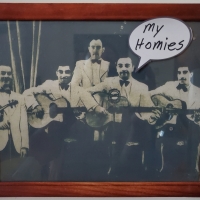DjangoBooks.com
Welcome to our Community!
Categories
- 20K All Categories
- 1.1K General
- 478 Welcome
- 59 Archtop Eddy's Corner
- 146 CD, DVD, and Concert Reviews
- 385 FAQ
- 26 Gypsy Jazz Italia
- 27 Photos
- 207 Gypsy Picking
- 21 Unaccompanied Django
- 15 Pearl Django Play-Along Vol.1
- 17 Gypsy Fire
- 45 Gypsy Rhythm
- 1.4K Gypsy Jazz University - Get Educated
- 131 Gypsy Jazz 101
- 228 Repertoire
- 224 History
- 708 Technique
- 51 Licks and Patterns
- 6 Daniel Givone Manouche Guitare Method Users Group
- 20 Eddie Lang Club
- 1.3K Gypsy Jazz Gear
- 805 Guitars, Strings, Picks, Amps, Pickups and Other Accessories
- 461 Classifieds
- 50 Recording
- 62 Other Instruments
- 18 Violin
- 5 Mandolin
- 22 Accordion
- 7 Bass
- 10 Woodwinds
- 348 Gypsy Jazz Events
- 143 North America
- 110 Europe
- 95 International










Comments
I use dyads and triads at times playing the solo part ... good emphasis and much less chance of stepping on his notes.
The half-dim shape (or "grip") is a beauty! I love the flexibility... play it over the II chord and then move it up 3 frets and play it again over the V7 for an nice altered sound. And of course, the m7b5 arp works everywhere the shape does. How cool is that?
Perhaps I'm confused on one issue... In your diagram you show it on the 3rd fret as a rootless G13, but without a 6th, wouldn't it be a G9?
I have another sequence which I play - I;m not claiming it's original, it's probably been done before but I came across it while noodling around. I'll draw it up in diagram form and explain how I use it when I get some free time
Alan
As I understand it, the half dim (or m7b5) = 1 b3 b5 b7, whereas the dim = 1 b3 b5 bb7 (or every 3rd note).
What's really cool is that whether you use that m7b5 grip as a 9th, a m6th or a m7b5, any arpeggio, scale or lick that fits one will fit the other too! In other words a Bm7b5 arpeggio also perfectly describes a G9 or a Dm6. I'm still learning this stuff but it's exciting and fun to share!
To be honest I hadn't/don't analyse the notes in the chords too much - if it fits the progression it'll do for me.
Alan
Maybe. I haven't seen the Gig Book, but Djoe is right: if you use all 4 notes of a min6 chord, then it's not diminished but half diminished (Amin6 = F#min7b5). If you only grab three notes, you get a shape, which could be either dim or min6.
If you want fuller dim chords based on the shape above, these would be your diminished options (on 5th fret this would be Bbdim). The latter has an added 13 on top, so it could also be called (again 5th fret) A13b9. It's very commonly played on Bbdim so I added it here.
http://www.jazzpartout.com